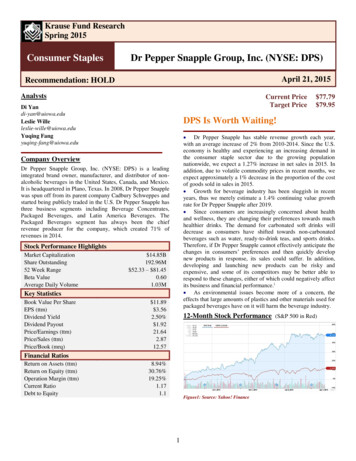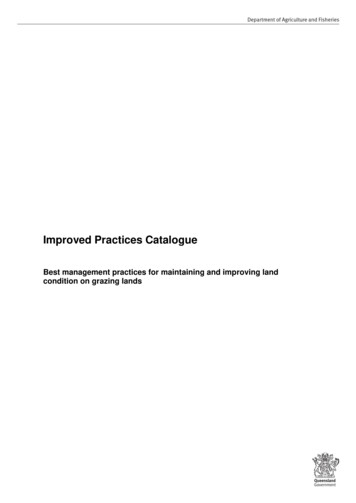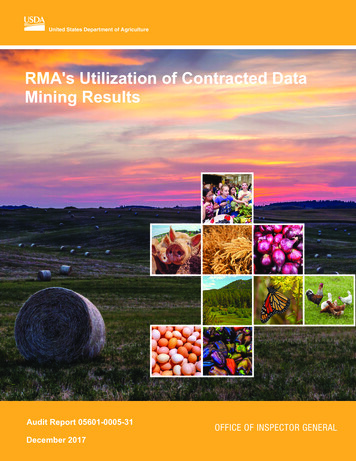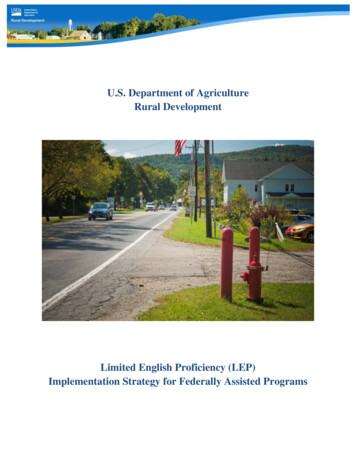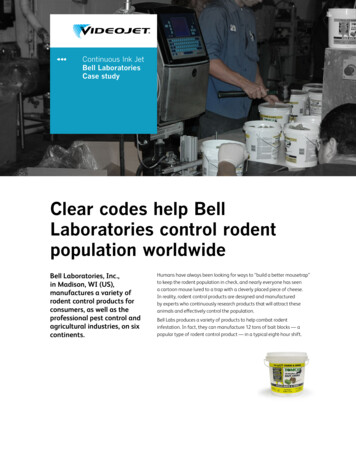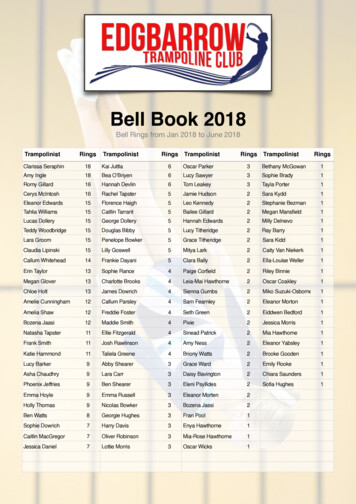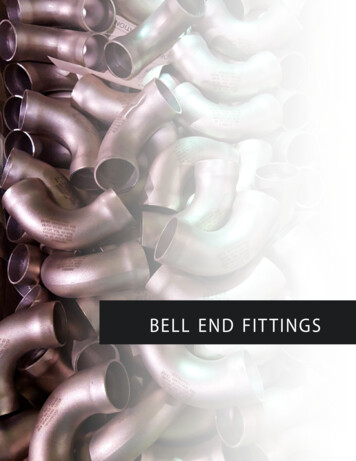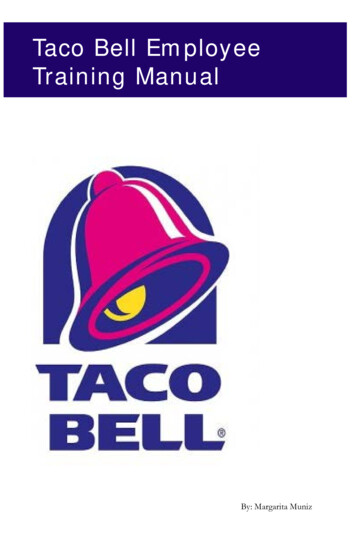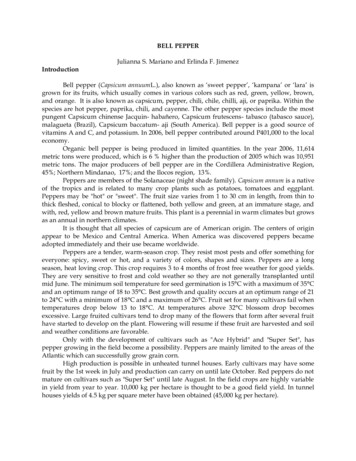
Transcription
BELL PEPPERJulianna S. Mariano and Erlinda F. JimenezIntroductionBell pepper (Capsicum annuumL.), also known as ‘sweet pepper’, ‘kampana’ or ‘lara’ isgrown for its fruits, which usually comes in various colors such as red, green, yellow, brown,and orange. It is also known as capsicum, pepper, chili, chile, chilli, aji, or paprika. Within thespecies are hot pepper, paprika, chili, and cayenne. The other pepper species include the mostpungent Capsicum chinense Jacquin- habañero, Capsicum frutescens- tabasco (tabasco sauce),malagueta (Brazil), Capsicum baccatum- aji (South America). Bell pepper is a good source ofvitamins A and C, and potassium. In 2006, bell pepper contributed around P401,000 to the localeconomy.Organic bell pepper is being produced in limited quantities. In the year 2006, 11,614metric tons were produced, which is 6 % higher than the production of 2005 which was 10,951metric tons. The major producers of bell pepper are in the Cordillera Administrative Region,45%; Northern Mindanao, 17%; and the Ilocos region, 13%.Peppers are members of the Solanaceae (night shade family). Capsicum annum is a nativeof the tropics and is related to many crop plants such as potatoes, tomatoes and eggplant.Peppers may be "hot" or "sweet". The fruit size varies from 1 to 30 cm in length, from thin tothick fleshed, conical to blocky or flattened, both yellow and green, at an immature stage, andwith, red, yellow and brown mature fruits. This plant is a perennial in warm climates but growsas an annual in northern climates.It is thought that all species of capsicum are of American origin. The centers of originappear to be Mexico and Central America. When America was discovered peppers becameadopted immediately and their use became worldwide.Peppers are a tender, warm-season crop. They resist most pests and offer something foreveryone: spicy, sweet or hot, and a variety of colors, shapes and sizes. Peppers are a longseason, heat loving crop. This crop requires 3 to 4 months of frost free weather for good yields.They are very sensitive to frost and cold weather so they are not generally transplanted untilmid June. The minimum soil temperature for seed germination is 15 C with a maximum of 35 Cand an optimum range of 18 to 35 C. Best growth and quality occurs at an optimum range of 21to 24 C with a minimum of 18 C and a maximum of 26 C. Fruit set for many cultivars fail whentemperatures drop below 13 to 18 C. At temperatures above 32 C blossom drop becomesexcessive. Large fruited cultivars tend to drop many of the flowers that form after several fruithave started to develop on the plant. Flowering will resume if these fruit are harvested and soiland weather conditions are favorable.Only with the development of cultivars such as "Ace Hybrid" and "Super Set", haspepper growing in the field become a possibility. Peppers are mainly limited to the areas of theAtlantic which can successfully grow grain corn.High production is possible in unheated tunnel houses. Early cultivars may have somefruit by the 1st week in July and production can carry on until late October. Red peppers do notmature on cultivars such as "Super Set" until late August. In the field crops are highly variablein yield from year to year. 10,000 kg per hectare is thought to be a good field yield. In tunnelhouses yields of 4.5 kg per square meter have been obtained (45,000 kg per hectare).
A green pepper is a highly nutritious vegetable. This bell shaped vegetable with a green,glossy exterior adds a dash of color to any dish. It is also referred to as a bell pepper. It has atangy taste that enhances food flavor. The inside has a small, white foam-like core with tinyseeds attached to it. This pepper isn’t “hot” due to the absence of capsaicin which gives pepperthe characteristic “hot” taste. Orange, yellow and red variants also exist. The pepper is packedwith nutrients. It is a good source of vitamins, minerals and phytochemicals.Various vitamins and phytochemicals found in green peppers have antioxidantproperties. The peppers contain vitamin A in the form of carotenoids as well as vitamins B6, B9and C, all of which are powerful antioxidants. These vitamins play a vital role in neutralizingfree radicals in the body which have the capacity to cause serious damage to cells during theirroaming activities. Free radicals also contribute to the build-up of cholesterol in blood vesselswhich increases the likelihood of stroke and heart disease. Besides their antioxidant properties,phytonutrients in green peppers play an anti-inflammatory role. This gives relief from pain andinflammatory conditions. It makes bell peppers a useful dietary item if you have rheumatoidarthritis or osteoarthritis. Phytonutrients also help to relax the airways and reduce wheezing inasthma cases.CULTURE AND MANAGEMENTA.Climatic Requirements. Sweet pepper requires cool weather for best fruit quality. In lowelevations, October to December planting is best. In mid and high elevations, it can begrown throughout the year.B.Soil Requirements. Sweet pepper grows well in any type of soil with a pH of 5.5 to 6.5.Production is best in sandy loam soil. Its temperature requirement ranges from 25 to 32degrees CelsiusC.Commercial Varieties1.‘California Wonder’–It matures at 120 days. The shape of the pepper is 4 lobed,weighing 60 grams. It grows best during the dry season. It is for fresh marketproduction.2.‘Cony Island’ (Condor) - It matures at 120 days. The shape of the pepper is conical,with an average length of 10 cm, with a green to red color, weighing 22 – 25 grams.It can be grown year round. It has long harvest duration and is highlyrecommended for commercialization.3.‘Gold Flame Hybrid ‘- It matures at 100 days. The shape of the pepper is blockybell, with a length of 15 - 16 cm, with green to yellow color, weighing 200 - 250grams. It has a very good shelf life and vigor. It is resistant to tobacco mosaic virus.4.‘Smooth Cayenne’ - It matures at 90 - 120 days. The shape of the pepper is conewith a green color becoming red when ripe. It can be grown year round. It hasthick glossy flesh tolerant to some diseases. It is sustainable for upland andlowland production.5.‘Sweet Plastic’ - It matures at 60 days. The shape of the pepper is cone, weighing 24grams. It can in all seasons. It is high yielding.
6.7.8.9.10.11.12.13.14.15.16.17.18.19.‘Tosca’ (Condor) - It matures at 120 days. It is bell shaped, with an average lengthof 8 cm, with a green to red color, weighing 100 - 130 grams. It can be grown yearround. It is good for outdoor growing and it has good vigor and shipping quality.It is resistant to bacterial wilt.F1 sweet blocky type ‘Redondo’ (Nunhems) - It matures at 75 days. The shape ofthe pepper is blocky, with an average length of 10 cm, with a deep green to shinyred color, weighing 150 - 200 grams. It can be grown year round under greenhousecondition. It is heat tolerant and has a parthenocarpic set. It is resistant to TMVraces, 1, 2, and 3.OP ‘Sweet California Wonder’ (Bonanza) - It matures at 75 days. The shape of thepepper is blocky, with an average length of 10 cm, with a dark green to red color,weighing 150 - 200 grams. It can be grown year round. It has a high yield potential.F1 ‘Sweet nun 3020 PP’ (Nunhems) - It matures at 75 days. The shape of the pepperis blocky, with an average length of 12 cm, with a green yellow color, weighing 300- 350 grams. It can be grown year round under greenhouse condition. It is resistantto tobamovirus and has a high yield potential.‘Bless’ Hybrid – It has a deep green color. It can be grown year roundIt has highyield in any season and is very prolific. It has a smooth, shiny and firm with toughskin allowing for a good shipping quality.‘Enterprise’ Hybrid - - It matures at 70 days. The shape of the pepper is blocky,with a green to red color, weighing 200 - 350 grams. It is resistant to bacterial spotraces 1, 2, 3 and TobamovirusPathotype PO.‘Haifa Wonder’- The shape of the pepper is blocky and with a green color. It has athick flesh; the plant is compact and early producing.‘Improved Smooth Cayenne’ Hybrid - - It matures at 90 – 100 days. The shape ofthe pepper is conical and with a green to red color. It can be grown year. It is aprolific variety, with a thick flesh and protected with a plastic like cover making itadapted to rainy season as well as dry season. It is tolerant to bacterial wilt,anthracnose and mosaic virus.‘King Solomon’- The shape of the pepper is slightly elongated and with a darkgreen color. It is firm and thick walled with a strong growing plant.‘Majesty’ Hybrid - It is light green in color. The plant is very strong and canwithstand high levels of disease pressure particularly bacterial wilt.‘Trinity’ Hybrid - The shape of the pepper is blocky, with a glossy deep greencolor, weighing 65 - 75 grams. It can be grown year round. The plants are strongagainst disease.‘Vega’- The shape of the pepper is blocky, with an average length of 8.2 cm, with agreen color, weighing 190 grams. The plants are early, slightly dwarf, shortinternodes, vigorous and have a good wind tolerance. It is very good for shipping.‘Kalahari 914’ Hybrid - It matures at 65 days. The shape of the pepper is blockyand weighing 130 grams. It is a high yielding variety that can yield as much 49tons per hectare.‘Kampana’ 133 Hybrid – It is a big fruited, high yielding sweet pepper variety thatadapts well in mid to high elevation areas.D. Seedling Production. One hectare would require 100 to 200g of seeds. Sow the seeds ingermination boxes with sterilized media composed of one part compost, 1 part burned
rice hull, and one part coir dust, at the depth of 0.5 cm. Use the same media for seedlingtrays. As a precaution against damping off, broadcast a small amount of fungicide overthe media. Water the sown seeds thoroughly for the first 3 days. Regulate watering assoon as the seeds have germinated. Harden the seedlings a week before transplantingthen gradually withhold water until they show temporary wilting. Seedlings 3-4 weekold are ready for transplanting.E. Land Preparation. Prepare the area thoroughly. Plow and harrow the field 2-3 timesuntil the soil is well pulverized. For small areas, make plots 0.75 to 1 meter wide for tworow/plot planting. In bigger areas, set furrows at 0.6 m to 0.75 m apart for single rowplanting. This can be adopted during dry seasons. Use raised bed method (20-30 cmhigh, 1 meter wide) during the wet season.F. Crop Establishmenta. Transplanting. Apply basally 10 g of complete fertilizer (16-16-16) in each hole.Application of 250 g of compost per hole is also recommended. This will maintainthe good texture and condition of the soil aside from supplementing itsfertility.Transplant during cool weather or in the afternoon when the sun is nottoo hot to avoid seedling shock. Transplant at a spacing of 0.3 to 0.5 meterbetween hills.b. Mulching. Use mulch to control weeds and promote better growth. Rice hull, ricestraw or plastic may be used. In case of the latter, make beds 1 meter wide andincorporate the required manure and fertilizer. Spread the mulch, covering thesides with soil. Make holes 0.5 m x 0.5 m apart.F. Fertilization. Sidedress 2 parts ammonium sulfate and 1 part muriate of potash at therate of 10 g/hill, 10 days after transplanting, then again at 30 days;1 part urea and 1 partmuriate of potash at the rate of 10 g/hill. Repeat application of 1 part urea and 1 partmuriate of potash, 50 days after transplanting at the same rate.Cultivate between theplant rows when the weeds are just starting to emerge. Three to four alternate off-baringand hilling-up are recommended to attain maximum yield control.G. Irrigation. Irrigate the field once every 7-10 days. Sufficient irrigation water is criticalduring the early vegetative stage and during flowering time until the peak of the fruitsetting stage.H. Pest Managementa. Thrips (Thripstabaci). Thrips attack the upper and lower side of the leaves bysucking the sap. Areas near the mid-vein are brown and dried up. The majordamage occurs on the undersides of new or old leaves. Managing the diseasethrough chemical controls- check plants frequently and treat when damage is firstobserved and destroy refuse and control weedsb. Aphids (Aphids gossypil).Young and adults feed on underside of leaves bysucking the sap. Leaves becomes distorted, stunted and often curled under. Theupper leaf surface is sticky and has a black moldy growth.Botanicalpesticides/compounds may be tried such as neem extract and water.There are
c.d.e.f.g.many natural enemies that will feed on aphids, thus helping to reduce thepopulations of this pest in the field. Natural enemies that produce larvae whichwill feed on aphids include syrphid flies, lacewings and the predaceous midge.Adults and larvae of minute pirate bugs, big eyed bugs, lady beetles, soldierbeetles and parasitic wasps like Diaeretiellarapaewill also consume aphids. Culturalcontrols include using high pressure sprinkler irrigation to knock the insects off ofplants, as well as using living mulch such as clover interplanted with the crop. Ifusing chemical controls, check plants frequently and treat when damage is firstobserved.Broad Mite (Polyhagotarsonemuslatus).Direct feeding of leaves of pepper causesthe leaves to become distorted and curled downwards. Young leaves are cuppeddownward and narrower than normal. Botanical pesticides/compounds may betried such as neem extract and water, or madre de cacao, oil and water.Tomato fruit worm. A small darkened partially healed hole at the base of the fruitis evident. The inside of the fruit has a cavity that contains frass and decay. Often,the caterpillar can be seen inside the fruit.Chemicals can be used.There are manynatural enemies that will help control these pests in fields. Ground beetles, spiders,damsel bugs, minute pirate bugs, assassin bugs, big eyed bugs, and lacewinglarvae will all attack the caterpillars. Cultural controls include pheromon
the pepper is blocky, with an average length of 10 cm, with a deep green to shiny red color, weighing 150 - 200 grams. It can be grown year round under greenhouse condition. It is heat tolerant and has a parthenocarpic set. It is resistant to TMV races, 1, 2, and 3. 8. OP ‘Sweet California Wonder’ (Bonanza) - It matures at 75 days. The shape of the pepper is blocky, with an average length .
